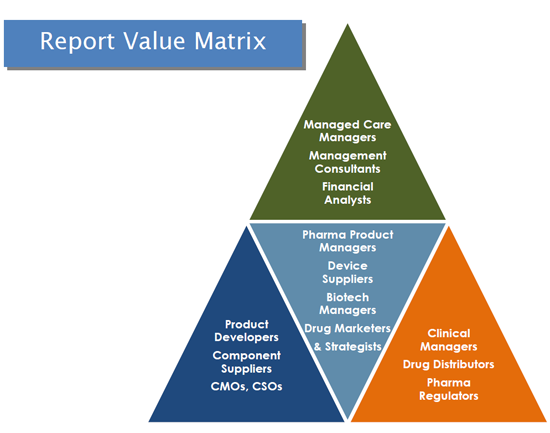 |
市场调查报告书
商品编码
1783024
生物学的注射药 - 技术,治疗方法,市场,策略,预测Therapeutic Biological Drugs for Injectable Delivery - Technologies, Therapeutics, Markets, Strategies & Forecasts |
||||||
器械工程为生物製剂输送提供新平台
生物製剂在研发管线和临床试验中持续超越所有其他新化学实体 (NCE)。由于生物製剂通常用于治疗慢性疾病,因此必须制定给药策略和治疗方案,使其能够长期使用,并且在许多情况下,能够方便那些可能因疾病状态而受限的患者自行给药。抗体、荷尔蒙、酵素和其他生物製剂的强效生理效应也推动了对安全性和依从性的需求。器械设计人员和药物开发人员之间的合作在药物开发週期的早期阶段就已开始,这通常使得器械设计能够根据特定药物疗法的生物利用度目标和药物动力学特征进行客製化。目前正在开发的新型注射用药物输送器械设计可能会为替代注射方法创造新的机会。器械供应商与製药公司之间的合作有望促进市场对用于多种新兴疗法的新型注射器械的接受,包括治疗性疫苗、DNA药物和蛋白质生物製剂。

本报告探讨了生物製剂注射剂市场,提供了用于注射生物製剂的注射器械的经济性、技术、疾病细分和机遇方面的资讯。
了解更多
- 产品与使用者需求驱动生物製剂器械的选择过程
- 用于注射生物製剂的注射器材的关键设计要素、技术和开发课题
- 生物製剂生产流程在开发过程中的变化如何影响器械的准备度,以及这些变化如何随着最新趋势而变化?
- 不同类别的生物製剂如何进行器械选择决策?治疗目标是什么?哪些细分市场?
- 药品-器材依赖性如何影响上市前后的产品生命週期管理?
- 影响生物製剂注射器材市场的关键经济、技术和监管因素
"Therapeutic Biological Drugs for Injectable Delivery: Devices, Therapeutics, Markets, Strategies and Forecasts" is a comprehensive evaluation and analysis of the technology, products and participants providing the driving force behind this evolving segment of the healthcare sector. The study is designed to provide drug company decision makers, drug delivery developers, device designers, healthcare marketers, and supply chain participants with a detailed understanding of the economics, technologies, disease segments, and commercial opportunities for injection devices for administering biologicals. Provider organization business managers, healthcare administrators and investors will also benefit from this study.
Device Engineering Providing New Platforms for Biological Drug Delivery
Biological drugs as a class continue to outpace all other NCEs in development pipelines and clinical trials. Because biological drugs most often target chronic conditions, dosing strategies and treatment protocols must be developed for long-term use, often for self-administration by patients who may have limitations directly related to their condition. The powerful physiological effects of antibodies, hormones, enzymes and other biological drugs also increase the need for safety and adherence. Cooperation between device designers and drug developers is occurring much earlier in the drug development cycle, allowing device designs in many cases to be tailored to the bioavailability targets and pharmacokinetic profiles of specific drug therapies. New injectable delivery device designs currently being developed will create new opportunities for alternative injection methods. Partnerships between device suppliers and pharmaceutical companies will foster market acceptance of new injection devices for a host of new therapies such as therapeutic vaccines, DNA-based drugs, and protein-derived biologics.

What You Will Learn:
- What are the product and user requirements that drive the biological drug-device selection process?
- What are the essential design factors, technologies and market development issues for injection devices capable of administering biological dugs?
- What is the impact of development-stage biological manufacturing process changes on device go-to-market readiness and how has it changed in recent years?
- How do device selection decisions align across biological drug classes? Therapeutic targets? Market segments?
- What is the impact of drug-device dependencies on pre- and post-marketing product life cycle management?
- What are the significant economic, technology, and regulatory factors affecting the market for biological drug injection devices?
Methodology:
Research methodology is based on primary research in the form of in-depth interviews with key market participants, technology developers, distributors, industry experts, and market influencers, a list that includes regulatory officials, industry trade groups, and materials standards organizations.
Primary data is evaluated and normalized against secondary sources including trade journal articles, technical literature, industry publications, company data sheets and published information, and statistical data from government agencies and trade associations.
Forecasts and projections of market demand and future market activity are derived using standard modeling and statistical techniques.
Table of Tables
Executive Summary
The Market Opportunity
- Unmet Patient Needs
- Biosimilars
- The Biological Drug Global Supply Chain
Biological Drug Delivery - Challenges and Limitations
- Drug Stability
- Pre- and Post-Manufacturing Engineering
- Lyophilization and Reconstitution
- Viscosities and Volumes
Drug Strategies & Therapeutic Protein Packaging
- As-Supplied Packaging
- Device Market Share
- Device Supplier Segment Activity
- Emerging Injection Devices for Biological Drugs
Injectable Biologicals - Product Analysis by Drug Class
- Cytokines
- Enzymes
- Fusion Proteins
- G-CSF/GM-CSF
- Hematopoietics
- Hormones
- Immune Modulators
- Insulins & GLP Analogs
- Monoclonal Antibodies
- Vaccines
Therapeutic Market Segment Analysis
- Cardiovascular
- Diabetes
- Hematology
- Immunology
- Metabolic
- Oncology
Market Factors
- Regulatory Issues
- Patient Preferences and Self-Administration
- Pre- and Post-marketing Device Evolution
- Compatibility Testing










